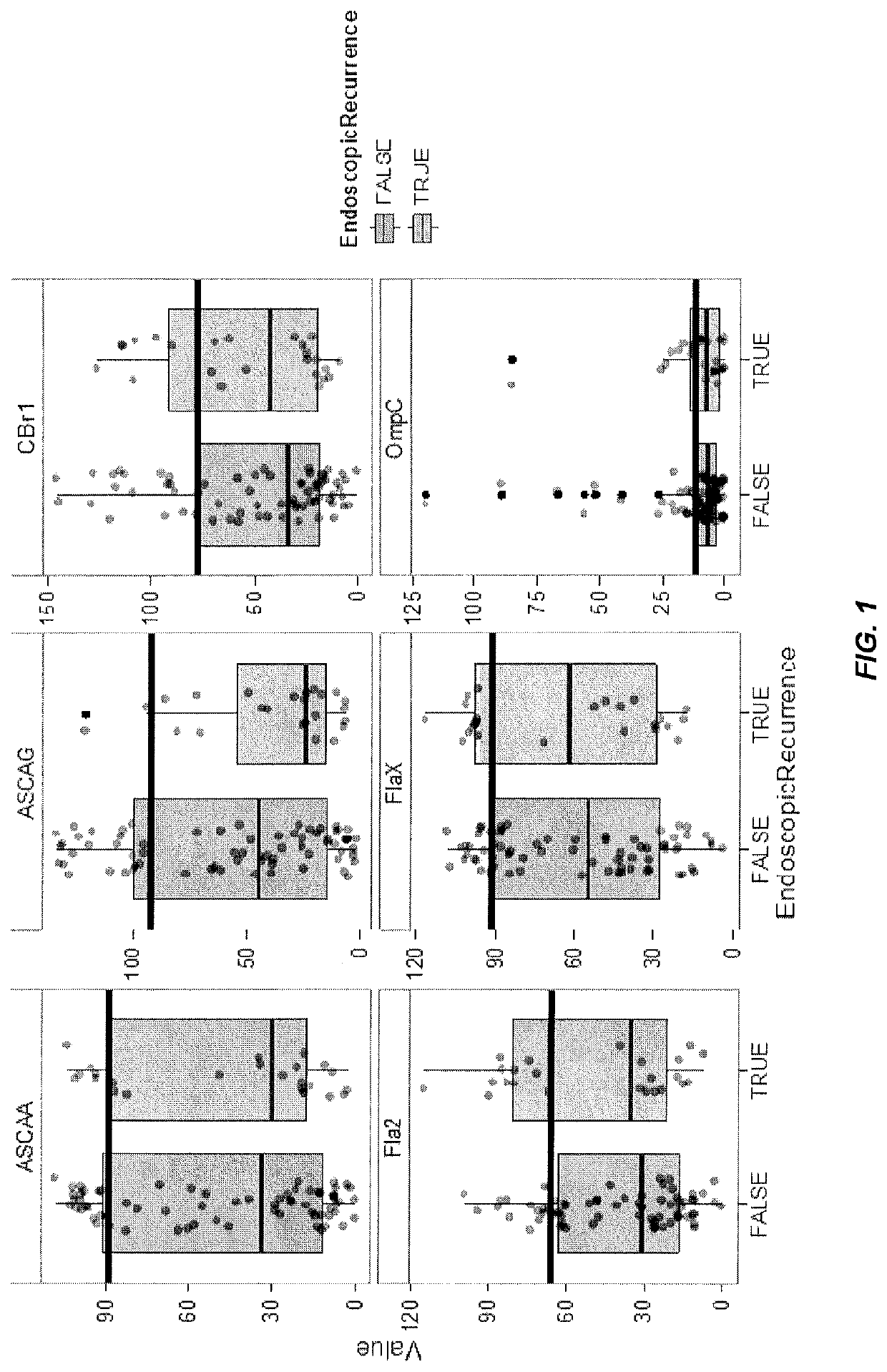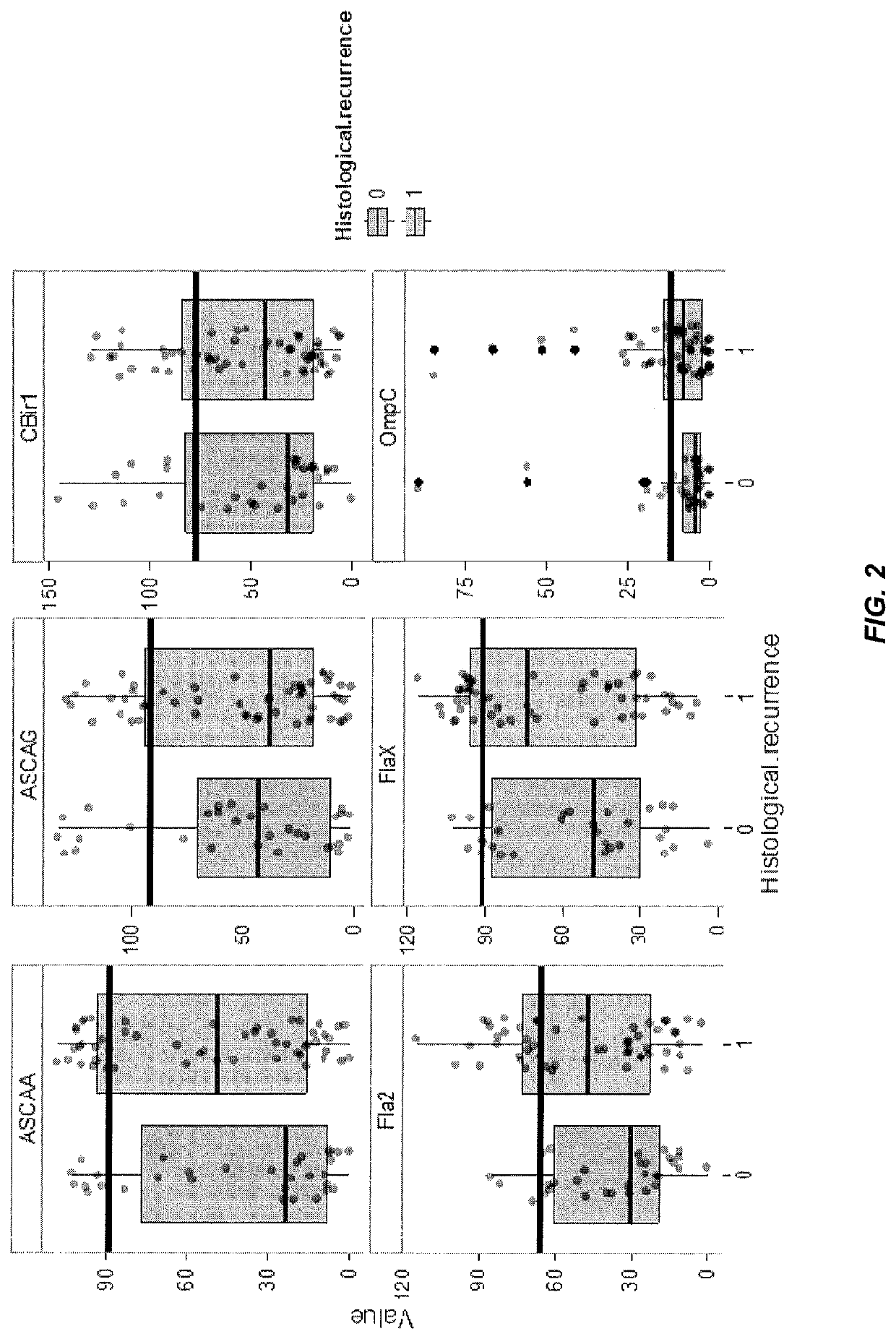Methods for predicting post-operative recurrence of Crohn's disease
a crohn's disease and postoperative recurrence technology, applied in chemical methods analysis, instruments, material analysis, etc., can solve the problems of cd being associated with an increased risk of intestinal cancer, bowel obstruction or changes in the caliber of feces, and recurrence can occur
- Summary
- Abstract
- Description
- Claims
- Application Information
AI Technical Summary
Benefits of technology
Problems solved by technology
Method used
Image
Examples
example 1
al Markers Predictive of Post-Operative Endoscopic Histological and Clinical Recurrence of Crohn's Disease
[0171]This example illustrates a method of utilizing a panel of serological markers in CD patients collected prior to right hemicolectomy to predict post-operative endoscopic, histological, or clinical recurrence.
Background
[0172]A majority of Crohn's disease (CD) patients will require a partial bowel resection during their disease course. Most of these patients will experience a postoperative recurrence of the disease. Endoscopy, histology, or radiography within the first year after surgery can reveal new epithelial lesions. The severity of these lesions predicts the recurrence of clinical symptoms and the need for additional surgical intervention.
[0173]Since endoscopy, radiology, and histology are a burden to the post-operative patient, predictors of recurrence are warranted. A wide range of clinical and histological features have been identified. However, literature often prov...
example 2
tive Serological Markers Predict Post-Operative Crohn's Disease Recurrence: Results from a Prospective Mono-Centric Trial
[0182]This example illustrates a method of utilizing a panel of serological markers in CD patients collected prior to an intestinal resection in conjunction with a clinical marker to predict post-operative endoscopic, or clinical recurrence.
Background
[0183]Preventing postoperative endoscopic (ER) and clinical recurrence (CR) remains a challenging issue in patients with Crohn's disease (CD) undergoing an intestinal resection. Several clinical and histological risk factors have been identified, and may guide selection of appropriate candidates for postoperative prophylactic CD therapy. We evaluated if a set of pre-operative serological markers could strengthen the prediction of postoperative ER and CR.
Methods
[0184]The study population of Example 1 was utilized for further analysis. At surgery, 27 patients were active smoking and 55 had an elevated C-reactive protein...
example 3
tion of ANCA Levels
[0187]This example illustrates an analysis of ANCA levels in a sample using an ELISA assay.
[0188]A fixed neutrophil enzyme-linked immunosorbent assay (ELISA) may be used to detect ANCA as described in Saxon et al., J. Allergy Clin. Immunol., 86:202-210 (1990). Briefly, microtiter plates are coated with 2.5×105 neutrophils per well from peripheral human blood purified by Ficoll-hypaque centrifugation and treated with 100% methanol for 10 minutes to fix the cells. Cells are incubated with 0.25% bovine serum albumin (BSA) in phosphate-buffered saline to block nonspecific antibody binding for 60 minutes at room temperature in a humidified chamber. Next, control and coded sera are added at a 1:100 dilution to the bovine serum / phosphate-buffered saline blocking buffer and incubated for 60 minutes at room temperature in a humidified chamber. Alkaline phosphatase-conjugated goat F(ab′)2 anti-human immunoglobulin G antibody (γ-chain specific; Jackson Immunoresearch Labs, I...
PUM
| Property | Measurement | Unit |
|---|---|---|
| time | aaaaa | aaaaa |
| time | aaaaa | aaaaa |
| time | aaaaa | aaaaa |
Abstract
Description
Claims
Application Information
 Login to View More
Login to View More - R&D
- Intellectual Property
- Life Sciences
- Materials
- Tech Scout
- Unparalleled Data Quality
- Higher Quality Content
- 60% Fewer Hallucinations
Browse by: Latest US Patents, China's latest patents, Technical Efficacy Thesaurus, Application Domain, Technology Topic, Popular Technical Reports.
© 2025 PatSnap. All rights reserved.Legal|Privacy policy|Modern Slavery Act Transparency Statement|Sitemap|About US| Contact US: help@patsnap.com



